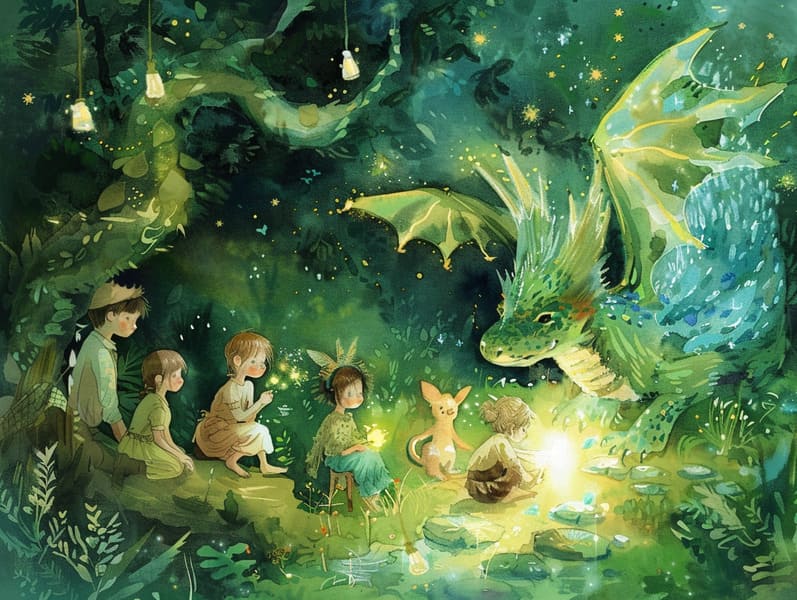Exploring the Roots of Short Fairy Tales with Their Unchanging Splendor.
Exploring the Roots of Short Fairy Tales with Their Unchanging Splendor.
Blog Article

Traditional fairy tales have timeless appeal. These narratives have been whispered from one generation to the next millennia before they were ever documented. They developed from a variety of civilizations, including Eastern traditions. They were initially told among grown-ups, often carrying themes and messages pertaining to the societal norms and beliefs of the time.
The Brothers Grimm, Jacob and Wilhelm, were among the first to collect many of these beloved stories. Their volume, "Grimm's Fairy Tales," included stories like "The True Bride," "The Story of Hansel and Gretel," and "Snow White," which have since become mainstays in the world of beloved fairy tales. Similarly, Hans Christian Andersen's charming stories, such as "The Mermaid's Tale," and "The Little Duckling," have touched hearts worldwide, securing their place in the pantheon of beloved fairy tales.
Despite being ancient, fairy tales remain as meaningful as ever, especially as children's bedtime stories. These charming stories are now available in diverse formats, including richly illustrated books, enchanting animations, and online storybooks.
Their continued relevance can be traced to several charming aspects:
Valuable Lessons: Old fairy tales often whisper important moral lessons. Stories like "The Story of the Boy Who Cried Wolf" teach the merit of sincerity, while "The Story of the Tortoise and the Hare" emphasize the benefits of perseverance and unassuming nature. These narratives offer children clear distinctions between good and bad, guiding their moral compass in a mild yet deep way.
Warmth and Understanding: Fairy tales frequently include individuals facing challenges and struggles, inspiring listeners to sympathize with their struggles and cheer for their triumphs. For instance, "Beauty and the Beast" teaches us the significance of appreciating inner worth to know the real person of a individual, promoting warmth and knowledge.
Cultural Appreciation: Many timeless fairy tales are rooted in the cultural contexts from which they originated. Exploring these stories can provide intriguing perspectives into different traditions, promoting a sense of world appreciation and acknowledgment.
Fantasy and Innovation: The supernatural elements in classic fairy tales—talking animals—awaken children’s imaginative ideas. These tales lead readers to imaginary realms, firing up creative thinking and a sense of marvel that lasts a lifetime.
Classic fairy tales are not only captivating but also pedagogical. They act as magical tools in fostering various brain and heart skills in kids. When fairy tales are told out loud, they foster speech development by introducing new terms and meanings and elaborate sentence structures. This practice also improves auditory skills and mindfulness, as little ones follow the story, keen to see what happens next.
Furthermore, conversing about the themes and characters of old fairy tales can sharpen cognitive skills and evaluative skills. Kids are guided to see patterns, make predictions, and realize cause and effect. These talks also aid children verbalize their thoughts and feelings, strengthening their emotional intelligence.
In today’s information age, the availability of digital fairy tales has made these tales more acquirable than ever. Internet resources and mobile apps provide vast collections of traditional fairy tales that can be accessed or listened via anytime, anywhere. Fairy tales voiced are particularly popular, presenting an fun way for young readers to savor these whimsical stories. Sound books and spoken videos take characters and settings to life, often accompanied by enchanting melodies and instrumentals that intensify the storytelling experience.
The timeless get more info charm of old fairy tales lies in their ability to evolve to present eras while retaining their key morals. Contemporary revisions of these narratives often incorporate more inclusive protagonists and modern settings, making them accessible to today’s audience. However, the underlying themes of heroism, charity, and fair-mindedness remain unchanged, continuing to touch listeners of all ages.
Classic fairy tales also offer a sense of reassurance and homeliness. They furnish a structured narrative with a straightforward beginning, middle, and end, often finishing with the wrap-up of conflicts and the triumph of virtue over corruption. This steadiness can be encouraging for young readers, sharing a sense of sturdiness in an constantly changing world.
Timeless fairy tales continue to charm and enlighten new generations, maintaining their grandeur and pertinence in modern society. As nighttime stories for kids, they bring a perfect blend of fascination and comprehension, cultivating moral values, empathy, and creativity. The prevalence of digital storybooks and the commonness of fairy tales narrated validate that these traditional tales remain acquirable to new generations.
By continuing and broadcasting these narratives, we continue to honor the rich tapestry of lore and cultural heritage. Whether you are browsing a artistically illustrated book, perusing a cyber library, or listening via an audio story, the fascination of old fairy tales is always within reach. These narratives point out of the endless strength of stories and its ability to hold us together across eras and regions.
If you are seeing a richly illustrated book, viewing a online library, or hearing an spoken story, the fascination of ancient fairy tales is always within reach.
These narratives highlight of the ageless spell of tales and its ability to tie us across time and space, establishing a link that charms and informs alike.